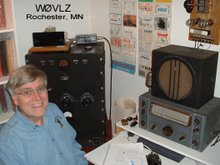Summits On The Air is an award scheme for radio amateurs and shortwave listeners that encourages portable operation in mountainous areas. See http://www.sota.org.uk . Basically "Activators" operating from mountain summits and "Chasers" both get credit towards awards.
As a SOTA activator I hiked the last feet to the summit and then set up my KX3 at the edge of the Steptoe Butte summit overlook. There are no trees on the summit so I strapped my 18' crappie pole to a rock pedestal, using it to support the high point of my 20 mtr end fed zepp.
I had posted to the SOTAwatch2 database an announcement of my intention to activate Steptoe Butte. My first CQ was picked up by the Reverse Beacon Network, compared to SOTA database and an activation spot automatically posted to the same SOTAwatch2 database. Instantly any SOTA chaster knew my frequency and operating status. I'm used to calling CQ for a while and getting one or, at most, two responses...suddenly it felt like I had a pileup to work, unfortunately I've no practice working pileups. In less than two hours I did work 15 stations in 9 states but I could have done better.
Notes to self for the next time:
- Copy directly to a log sheet rather than my QSO pad
- Avoid using my cellphone clock requiring me to punch it to get the current time
- Narrow selectivity first
- Use RIT to tune through the pileup for calls
and, a related safety item:
- If the antenna is within easy reach of curious public, hang a "Do Not Touch" note on it.
Hopefully next time I won't leave so many chasers without a QSO.







